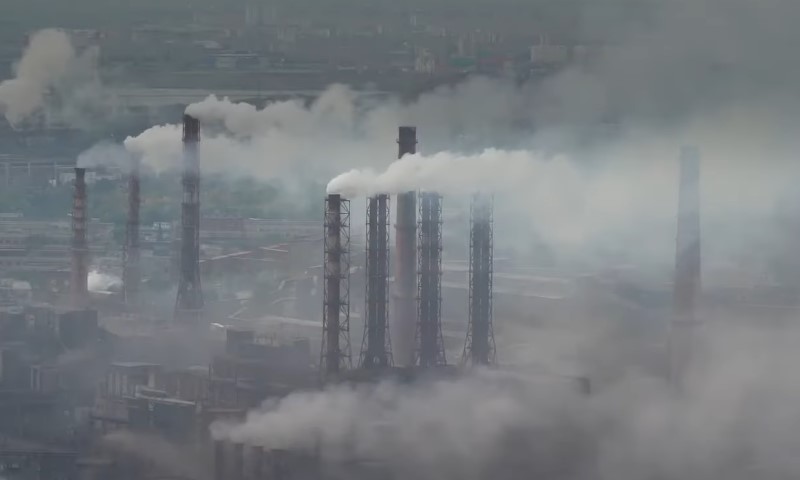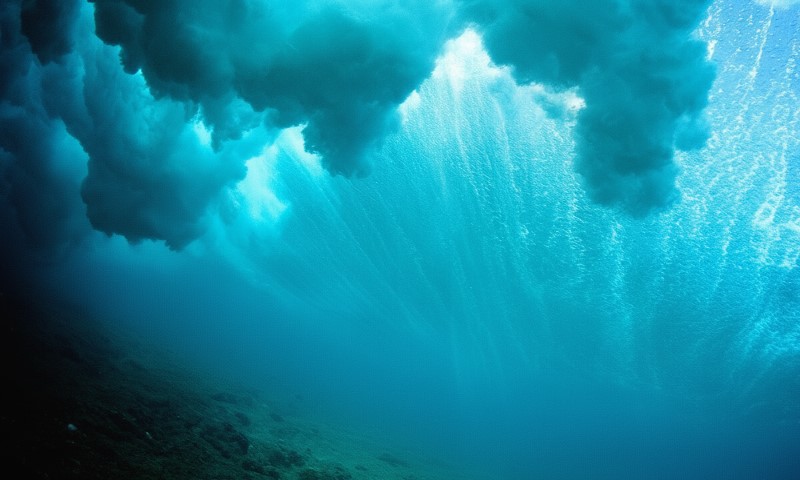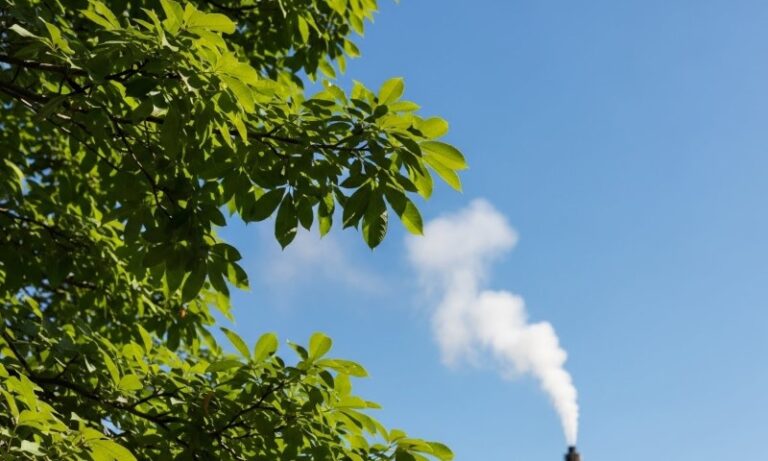Photosynthesis rarely gets framed as a system that quietly holds Earth together, yet that is exactly the role it plays. Every breath of oxygen, every forest canopy, every soil layer rich with life traces back to a single biological action that pulls carbon out of the air and surface ocean and locks it into living matter.
When that process speeds up, slows down, or shifts location, the entire carbon cycle reshapes itself. Atmospheric CO₂ follows along for the ride.
Today, we prepared a look at why photosynthesis sits at the center of the carbon cycle, how its influence plays out across land and ocean, and why small changes in plant and plankton activity show up at the planetary scale. Let’s get started.
Highlights
- Photosynthesis acts as the main biological entry point that moves carbon from the air and the surface ocean into living systems.
- Small shifts in photosynthetic activity can change atmospheric CO₂ at a planetary scale.
- Land plants and ocean plankton drive the fast carbon cycle that affects climate on human timescales.
- Without photosynthesis, carbon sinks would collapse, and atmospheric CO₂ would rise continuously.
Photosynthesis as the Main Gateway for Carbon

Carbon moves constantly across Earth, but photosynthesis acts as the primary biological doorway that moves carbon from the atmosphere and surface ocean into living systems.
Food webs, forests, soils, fisheries, climate behavior, ocean chemistry, all of it traces back to carbon entering life through photosynthetic activity.
Without photosynthesis, carbon would remain mostly locked in inorganic forms. Respiration, decay, and combustion would continue returning carbon to the air, but nothing would balance those losses on human timescales.
That imbalance matters because atmospheric CO₂ responds directly to the rate at which carbon enters and exits living systems.
Fast and Slow Carbon Cycles, and Where Photosynthesis Fits
Earth runs two overlapping carbon cycles that operate on very different clocks.
The Fast Biological Cycle
The fast cycle runs on seasons, years, and lifetimes. It involves:
- Plants and plankton fixing carbon
- Animals consuming organic matter
- Microbes breaking down dead material
- Soils and surface oceans exchanging CO₂ with the air
Photosynthesis dominates the “in” direction of this cycle, pulling CO₂ into living tissue. Respiration, decomposition, and fire dominate the “out” direction, returning carbon to the atmosphere.
The Slow Geological Cycle
The slow cycle spans thousands to millions of years and involves rocks, sediments, weathering, and long-term burial. Most of Earth’s carbon sits here.
NASA’s overview places roughly 65,500 billion metric tons of carbon in rocks, far more than in air, oceans, or living matter.
Photosynthesis does not control that massive geological store. It controls something more immediate: how much carbon stays in the atmosphere over years, decades, and centuries.
Carbon Reservoirs and Their Scale

Seeing the relative size of carbon reservoirs helps explain why photosynthesis carries such weight in climate discussions. Values below are commonly expressed as gigatons of carbon (GtC) and vary by method, but the scale differences are the key point.
| Reservoir | Approximate carbon stored |
| Atmosphere | ~800 GtC |
| Plant biomass (land) | ~550 GtC |
| Soil carbon (land) | ~2,300 GtC |
| Surface ocean | ~1,000 GtC |
| Deep ocean | ~37,000 GtC |
| Fossil carbon (geologic store shown in diagrams) | ~10,000 GtC |
| Reactive sediments | ~6,000 GtC |
Photosynthesis does not fill the largest box, rocks do. Yet photosynthesis controls how carbon partitions between air, land, and ocean on timescales that matter to people, ecosystems, and climate policy.
What Photosynthesis Actually Does to Carbon
At a chemical level, photosynthesis uses light energy to turn carbon dioxide and water into energy-rich organic matter, releasing oxygen as a byproduct. NASA presents the simplified form as:
CO₂ + H₂O + energy → CH₂O + O₂
Britannica gives the familiar balanced reaction:
6CO₂ + 6H₂O → C₆H₁₂O₆ + 6O₂
From a carbon cycle perspective, three outcomes matter most.
Carbon Fixation
Carbon leaves the atmosphere or surface ocean and becomes part of sugars and plant or plankton tissue.
Biomass Construction
Fixed carbon builds trunks, leaves, roots, plankton cells, and all the food webs that depend on them.
Storage and Transfer
Some carbon remains in wood or soils for decades to centuries. Some move rapidly through food webs. Some sink into deeper waters and sediments.
Photosynthesis sets the size of the incoming carbon stream. Everything else in the fast cycle reacts to that starting point.
The Carbon Flows Most People Never Visualize
View this post on Instagram
Human CO₂ emissions receive most of the attention, and rightly so, but natural carbon exchanges are larger still.
NASA’s fast cycle diagrams show land photosynthesis pulling about 120 GtC per year from the atmosphere, with an added +3 GtC per year term shown as a perturbation.
Land respiration and microbial decomposition each return roughly 60 GtC per year back to the air.
Oceans exchange carbon with the atmosphere at about 90 GtC per year in each direction, plus an added +2 GtC per year net uptake term toward the ocean.
| Fast cycle flow | Approximate rate |
| Land photosynthesis (gross uptake) | ~120 GtC per year (+3 shown) |
| Plant respiration | ~60 GtC per year |
| Microbial respiration and decomposition | ~60 GtC per year |
| Air sea CO₂ exchange | ~90 GtC per year each way (+2 shown) |
| Human emissions (diagram value) | ~9 GtC per year |
Photosynthesis sits at the start of the land loop. If uptake weakens, the outflows keep running, and atmospheric CO₂ rises.
Gross Primary Production and Why Scale Matters
Photosynthesis often gets summarized as forests or oceans “absorbing carbon,” but scientists track it more precisely through gross primary production, or GPP. GPP measures total CO₂ uptake before subtracting respiration. NASA highlights GPP as a major pathway, removing CO₂ from the atmosphere.
Historically, terrestrial GPP has been cited at around 120 petagrams of carbon per year. More recent work referenced by Oak Ridge National Laboratory reports an updated estimate near 157 PgC per year for land plants, using modeling linked to carbonyl sulfide uptake as a tracer for photosynthetic activity.
That difference matters because:
- GPP represents the intake pipe, even when net storage remains modest
- Net land carbon gain depends heavily on respiration, decay, and disturbance
- A few percent change in a 120 to 157 PgC per year flow shifts atmospheric CO₂ in measurable ways
Photosynthesis earns its importance partly through sheer scale.
Seasonal CO₂ Breathing Written in the Air
Atmospheric CO₂ records show a regular rise and fall each year, especially in the Northern Hemisphere.
CO₂ drops during spring and summer as vegetation grows, then rises through fall and winter as respiration and decay dominate. NASA illustrates a seasonal drawdown peaking near 2 ppm in late summer in one visualization.
Scripps measurements describe the same pattern, with stronger swings at higher northern latitudes because land vegetation drives the signal.
Photosynthesis creates the downward stroke of that sawtooth. Respiration and decomposition create the upward stroke.
Remove photosynthesis, and the breathing stops. CO₂ would climb steadily instead.
Photosynthesis as the Foundation of Land Carbon Storage
Carbon fixed by plants does not all behave the same way after uptake.
Short-Lived Tissues
Leaves and fine roots cycle carbon back to the atmosphere quickly through respiration and decay.
Long-Lived Biomass
According to DOE, wood and perennial tissues can store carbon for decades or centuries, depending on disturbance, harvest, and climate.
Soils
Carbon enters soils through litter, root turnover, and microbial processing. Soil carbon can persist from years to centuries, sometimes longer in cold or waterlogged conditions.
The US Department of Energy emphasizes that plants absorb CO₂ during photosynthesis and store significant amounts in roots, grasslands, forests, and soils, with carbon returning as plants and soils decay.
Wetlands as a Special Case
Wetlands draw down CO₂ through photosynthesis, yet anaerobic conditions often produce methane.
The US Geological Survey highlights wetlands as systems that remove CO₂ while also releasing CO₂ and methane during respiration. Net climate impact depends on both gases and local conditions.
Photosynthesis supplies the carbon. Ecosystem processes decide how long it stays put.
Photosynthesis Makes Land and Ocean Sinks Possible

Global carbon budgets separate gross flows from net sinks that affect atmospheric buildup. According to the Global Carbon Budget 2024 FAQs, averaged from 2014 to 2023:
- The land CO₂ sink absorbed about 11.7 GtCO₂ per year, around 29% of total CO₂ emissions
- The ocean CO₂ sink absorbed about 10.5 GtCO₂ per year, around 26% of total CO₂ emissions
Converted to carbon units, 11.7 GtCO₂ per year equals about 3.2 GtC per year, while 10.5 GtCO₂ per year equals about 2.9 GtC per year. Those net numbers sit far below GPP because most fixed carbon returns to CO₂.
Photosynthesis remains the entry step. Without it, net sinks would shrink toward zero or flip to sources.
Ocean Photosynthesis, Often Underestimated
Marine photosynthesis occurs mainly in the sunlit surface layer, carried out by phytoplankton and other microscopic producers. Its importance shows up in several ways.
Carbon Uptake and Food Webs
Phytoplankton take up CO₂ dissolved in seawater, convert it into organic matter, and support marine food chains from zooplankton to fisheries.
Oxygen Production
NOAA’s National Ocean Service estimates roughly half of Earth’s oxygen production comes from the ocean, largely from plankton.
Prochlorococcus alone can produce up to 20% of oxygen in the biosphere. NASA also describes phytoplankton as producing about half of Earth’s oxygen.
The Biological Pump
Some marine organic carbon sinks from the surface to deeper waters and sediments. Even though much is recycled by respiration, the fraction that sinks stays out of contact with the atmosphere for decades to centuries.
Ocean photosynthesis shapes how carbon partitions between the surface and the deep ocean, even though physics and chemistry also play large roles.
Ocean Sinks and Biological Influence

The net ocean sink reported in carbon budgets reflects CO₂ uptake driven by solubility, circulation, and biology combined.
The Global Carbon Budget 2024 paper reports an ocean sink of 2.9 ± 0.4 GtC per year for 2014 to 2023, around 26% of total CO₂ emissions, with signs of stagnation after rapid growth earlier in the century.
Marine photosynthesis influences that sink by controlling how much carbon moves from surface waters to depth. Warming, stratification, and nutrient changes can alter phytoplankton activity, reshaping the biological pump.
Photosynthesis as Feedback and Vulnerability
Photosynthesis can slow CO₂ rise, yet it remains sensitive to climate stress. The Global Carbon Budget 2024 FAQs note modeling evidence that climate change already reduces land and ocean sinks by about 20% and 7%, respectively.
Key mechanisms include:
- Heat and drought reducing photosynthetic rates and increasing plant mortality
- Wildfires and decomposition pulses returning stored carbon rapidly
- Ocean warming lowering CO₂ solubility and altering circulation
Photosynthesis starts the carbon ledger. Climate stress influences every line that follows.
Real Examples That Show Photosynthesis at Work
Photosynthesis shows its influence most clearly when abstract numbers turn into real places and real outcomes. Forests, farms, wetlands, and oceans all reveal how carbon moves once plants and plankton start pulling CO₂ out of the air and water.
Forest Regrowth and Management
Forest regrowth builds biomass through photosynthesis, storing carbon for decades when disturbance stays limited. Fires, pests, and harvest can reverse gains quickly. DOE emphasizes both uptake and release in forest systems.
Agriculture
Crops fix large amounts of carbon, yet most returns to the atmosphere within a year through harvest and decay. Longer retention requires soil-focused practices that build stable carbon pools.
Wetlands and Coastal Systems
Wetlands pull CO₂ down but also emit methane. Measurement must account for both gases, as USGS notes.
Ocean Productivity Shifts
Phytoplankton blooms draw down CO₂ locally and produce oxygen, yet most carbon recycles near the surface. A smaller fraction sinks, supporting longer-term sequestration. NOAA reminds that oxygen production and consumption remain tightly linked.
Why Photosynthesis Stays Central
Photosynthesis matters because it performs the single most important biological act in the carbon cycle: converting inorganic carbon into living matter at massive scale. It drives the largest annual CO₂ exchanges, creates the seasonal breathing of the atmosphere, and makes land and ocean sinks possible.
Net climate benefit depends on what happens after uptake, including respiration, decay, disturbance, and long-term burial. Without photosynthesis, the carbon cycle that supports life and moderates climate simply would not function.

